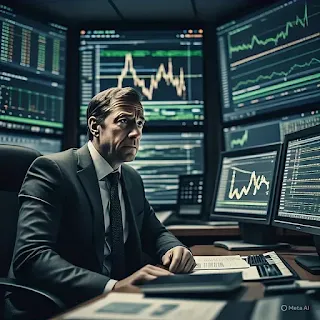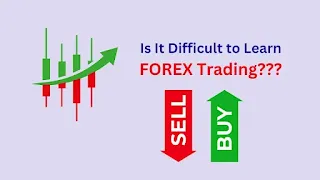A Trader's Tale: Your First Step into the World's Biggest Financial Playground
Hey there, future trader.
Let me take you back a bit. When I was a kid, my friends and I were obsessed with trading cards. I’d trade two of my common cards for one of my friend’s shiny, rare ones. We didn’t call it ‘trading’ or ‘investing’. It was just a fun game. We both walked away happy, feeling like we had gotten the better deal.
Now, imagine doing that, but instead of trading cards, you're trading the money of different countries. And instead of a schoolyard, your playground is the entire world.
That, in its simplest form, is what I do every day. I’m a Forex trader, and I want to tell you a story about this incredible world.
It’s a world that seems complex and intimidating from the outside, full of strange words and squiggly lines on charts. But I promise you, by the end of this, you'll see it for what it is: a world of opportunity, logic, and fascinating stories. A world that even a curious 7th grader can begin to understand.
Suggested for You
The Secret Market All Around You
Have you ever travelled to another country? Maybe on a vacation? With your family?
Remember how your parents had to exchange your home country's money for the money of the country you were visiting?
That's a Forex transaction!
You were participating in the Foreign Exchange market, or Forex (FX) for short. It’s the biggest financial market in the world. How big, you ask?
A Staggering Statistic: The Forex market trades over $7.5 trillion every single day. That's like every single person in the world spending about $900 every single day! It makes the stock market look like a small-town grocery store in comparison.
Unlike the stock market, which has a physical location like the New York Stock Exchange, the Forex market is everywhere and nowhere at the same time. It’s a massive, decentralised network of banks, financial institutions, and individuals like me, all connected through the internet.
Related Article: What is Forex Trading and How Does it Work?
It’s a 24-hour market, opening in Sydney on Monday morning and closing in New York on Friday evening, following the sun around the globe.
Cracking the Code: The Tug-of-War of Currencies
In Forex, you don't just buy 'money'. You always trade one country's currency for another. This is why currencies are always quoted in pairs.
Think of a currency pair like a tug-of-war.
Let's take the most popular pair: EUR/USD.
EUR is the Euro, the currency used by many countries in Europe.
USD is the United States Dollar.
The first currency in the pair (EUR) is the base currency. This is the one you are buying or selling. The second currency (USD) is the quote currency. This is the one you are using to make the transaction.
Related Articles:
Differences Between Base Currency and Quote Currency
What are FX Quote Conventions?
If the price of EUR/USD is 1.0800, it means that 1 Euro is worth 1.0800 US Dollars.
If you believe the European economy is going to get stronger, you would 'buy' the EUR/USD pair. You are betting that the Euro will win the tug-of-war and become stronger than the US Dollar. If the price goes up to 1.0900, you’ve made a profit.
If you think the US economy will do better, you would 'sell' the EUR/USD pair. You are betting that the US Dollar will win the tug-of-war. If the price drops to 1.0700, you’ve also made a profit.
It’s a constant battle between economies, and as a trader, you're picking a side.
Here are some of the main players in this global tug-of-war:
The Secret Language: Pips, Lots, and That Magical Word, Leverage
Now, let's learn a few secret words that all traders use.
1. The Pip: The Tiny Steps of Price
A PIP is the smallest change in value a currency pair can make. For most pairs like the EUR/USD, it's the fourth number after the decimal point.
If EUR/USD moves from 1.0800 to 1.0801, it has moved up by 1 pip.
These tiny steps might seem insignificant, but in the world of Forex, even these small movements can lead to significant gains or losses. Think of it as a single drop of water. One drop is nothing, but millions of drops can create an ocean.
Related Article:
Understand PIP in Detail
2. The Lot: How Big is Your Bet?
A lot is simply the size of your trade. Think of it like ordering a pizza. You can get a small, medium, or large one. In Forex, we have:
Micro Lot (1,000 units of currency): The small pizza. Great for beginners.
Mini Lot (10,000 units): The medium pizza. For those with a bit more experience.
Standard Lot (100,000 units): The large, party-sized pizza. For the big players.
The size of your lot determines how much money you make or lose per pip movement. A bigger lot means bigger potential profits, but also bigger potential risks.
Related Article:
What is a Lot? Understanding the Calculations of Trading Volume in Detail
How to Determine the Trading Lot Size? Essential Metrics, Calculation Strategies
3. Leverage: The Double-Edged Sword
This is the concept that attracts many people to Forex, but it's also the most dangerous if not understood.
Imagine you want to control a big, powerful machine, but you only have a little bit of strength. Leverage is like a special lever that multiplies your strength, allowing you to control that machine.
In Forex, your broker (the company that gives you access to the market) provides you with leverage. A leverage of 100:1 means that for every $1 you have in your account, you can control $100 in the market.
This sounds amazing, right? It allows you to make significant profits from small price changes with a small initial investment.
But here is the most important lesson you will ever learn: Leverage magnifies your losses just as much as it magnifies your profits. If the trade goes against you, that powerful machine can run you over. You must respect leverage. Always use it cautiously. It’s a tool, not a toy.
Related Articles:
How to Calculate Leverages the Right Way?
Understanding the Working Procedure of Leverages in the Forex Market
Forex Trading Analysis: Understanding the Best Methods
Placing Your Order: The Simple Acts of Buying and Selling
To enter a trade, you place an order with your broker. There are two basic types:
Market Order: This says, "I want to buy or sell right now, at the current market price!" It's instant. You see a price you like, and you jump in.
Limit Order: This is a bit more patient. It says, "I want to buy or sell, but only if the price reaches a specific level that I think is better." For example, you might place a limit order to buy EUR/USD only if it drops to a cheaper price.
That's it. Every complex trading strategy you'll ever hear about boils down to these simple actions of buying and selling.
The Big Question: How Do You Know When to Buy or Sell?
Ah, the million-dollar question. Literally.
Traders generally use two types of analysis to predict where the price might go next
Technical Analysis (The Chart Detective): These traders are like detectives who believe all the clues are in the price chart itself. They look at historical price patterns, use indicators (special tools that analyse price), and believe that history tends to repeat itself. They look at the "what" of the price, not the "why."
Fundamental Analysis (The News Reporter): These traders are more like investigative journalists. They look at the "why" behind price movements. They study a country's economic health, interest rates, employment figures, political stability, and major news events. A strong economy generally means a strong currency.
Which one is better? The honest answer is that many successful traders use a combination of both. They use fundamental analysis to get a big-picture view of which currency might get stronger and technical analysis to find the perfect moment to enter or exit a trade.
Related Articles:
Understanding Technical Analysis in Forex Trading in Detail
Predicting Forex Movements: What Signs to Follow
Your Journey Begins Now
We’ve covered a lot. We’ve journeyed from a simple childhood trade to the vast, fast-paced world of Forex. You’ve learned its language—pairs, pips, and lots. You’ve seen its power through leverage.
So, what now? Do you feel that spark of curiosity? Do you want to know more?
If you do, your journey starts not with money, but with knowledge. Before you even think about trading with real money, do this:
1) Open a Demo Account: Almost every broker offers a free demo account with "play money." It's a trading simulator. You can practice everything we've talked about in a 100% risk-free environment. This is your training ground.
2) Read. Learn. Absorb: Read books. Follow financial news. Watch videos. The more you learn, the better you'll understand the stories behind the charts.
3) Be Patient: This is not a get-rich-quick scheme. It’s a marathon, not a sprint. Treat it like learning to play a musical instrument or a new sport. It takes practice, discipline, and a deep respect for the game.
Related Articles:
Top Economic Factors that Affect the Forex Trading Market Worldwide
The world of Forex is waiting. It’s a world that rewards patience, punishes greed, and offers a lifetime of learning. It’s the biggest tug-of-war on the planet, and you now have the basic guidebook to understand it.
Take that first, small step. The story is just beginning.
Suggested articles for you:















